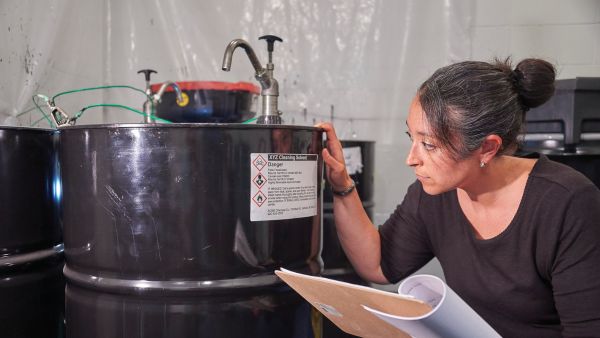Navigating HazCom Compliance: Answering Common Questions About SDSs and Written Programs
Rachel Krubsack, Editor - EHS
February 25, 2025

If OSHA came knocking, would your company face fines for Hazard Communication (HazCom) violations? From missing or inaccessible Safety Data Sheets (SDSs) to lack of a written HazCom program and chemical inventory, there are a number of ways companies get tripped up. Following are some common questions we get regarding SDSs and the written program.
Q: What do we have to include in our written HazCom program?
A: The written HazCom program essentially describes how your company is complying with the HazCom Standard. It must address:
- Labels and other forms of warning (i.e., the labeling system used in the workplace);
- SDSs (i.e., where and how they’re stored);
- Employee information and training (i.e., when/how often are employees trained and what’s covered in the training);
- The hazards of non-routine tasks, such as cleaning out reactor vessels (if applicable);
- The hazards associated with chemicals in unlabeled pipes in employees’ work areas (if applicable); and
- Multi-employer workplaces (if applicable).
Another requirement of the written program is the chemical list or inventory. This is a list of all hazardous chemicals known to be present in the workplace, even if they’re in storage. It must contain the product identifier, such as the product name or number, from the corresponding SDS and label.
Q: How do we address multi-employer worksites in our written HazCom program?
A: Where there’s more than one employer operating on a site, and employees may be exposed to the chemicals used by the other employers, your written HazCom program must address:
- How on-site access to SDSs will be provided to the other employer(s). You don’t have to physically give the other employers the SDSs, but you must inform others of where the SDSs are maintained.
- How these employers will be informed of any needed precautionary measures, such as personal protective equipment.
- How the other employers will be informed of your in-house labeling system, if it’s different than that on shipped containers of hazardous chemicals.
OSHA allows you to decide on the method of information exchange.
Each employer on a multi-employer worksite must make a written HazCom program available to their own employees, whether they generate the hazard, or the hazard is generated by other employers on the site.
Q: If we receive the same chemical from different manufacturers. Do we need to maintain an SDS from each manufacturer?
A: Yes, the SDS must be specific to the product and manufacturer.
Q: If we store SDSs electronically, do we still have to maintain paper copies?
A: OSHA says there must be a backup procedure or system in place in case the electronic system isn’t functioning. One option is to maintain paper copies.
Q: We have warehouse employees who handle sealed boxes of chemicals but don’t actually open or use them. Do we have to have SDSs for these chemicals?
A: The requirement for SDSs in this situation is found at 1910.1200(b)(4) and says that employers must:
- Maintain copies of any SDSs that are received with incoming shipments of the sealed containers of hazardous chemicals,
- Obtain an SDS as soon as possible for sealed containers of hazardous chemicals received without an SDS if an employee requests it, and
- Ensure that SDSs are readily accessible during each work shift to employees when they’re in their work area(s).
Q: Do we need an SDS for consumer products?
A: The consumer product exemption at 1910.1200(b)(6)(ix) can be confusing. These products are exempt from HazCom where the employer can show they’re used in the workplace for the purpose intended by the chemical manufacturer or importer, and the use results in a duration and frequency of exposure which isn’t greater than what could reasonably be experienced by consumers when used for the intended purpose.
It’s possible that you could have some consumer products that require an SDS and some that don’t, depending on their use. For example, if a cleanser is used occasionally by employees to wipe down their desk, that would meet the consumer use exemption. If that same cleanser is used for custodial or janitorial purposes, where its use exceeds that of a typical consumer, you need an SDS for it.
Q: OSHA says SDSs must be readily accessible. Is there a distance requirement?
A: There’s no distance requirement, but employees must be able to access SDSs in their work area within each work shift. If SDSs are stored electronically, employees must be trained to use the system. There must be no barrier to access, such as storing SDSs in a locked cabinet or having to ask a supervisor for an SDS.
Summary
Managing Hazard Communication (HazCom) compliance can be overwhelming, with requirements ranging from maintaining accurate Safety Data Sheets (SDSs) to ensuring multi-employer worksite coordination. Common questions about written programs, electronic SDS storage, and consumer product exemptions highlight the complexity of compliance.
A chemical management service can simplify these challenges by providing expert guidance, streamlining SDS organization, and ensuring that your HazCom program meets OSHA’s requirements. With professional support, businesses can avoid costly fines, enhance workplace safety, and ensure that employees have immediate access to critical chemical hazard information.
Learn more about J. J. Keller's Chemical Management Service!